Japanese Traditional Boatbuilding Apprenticeship
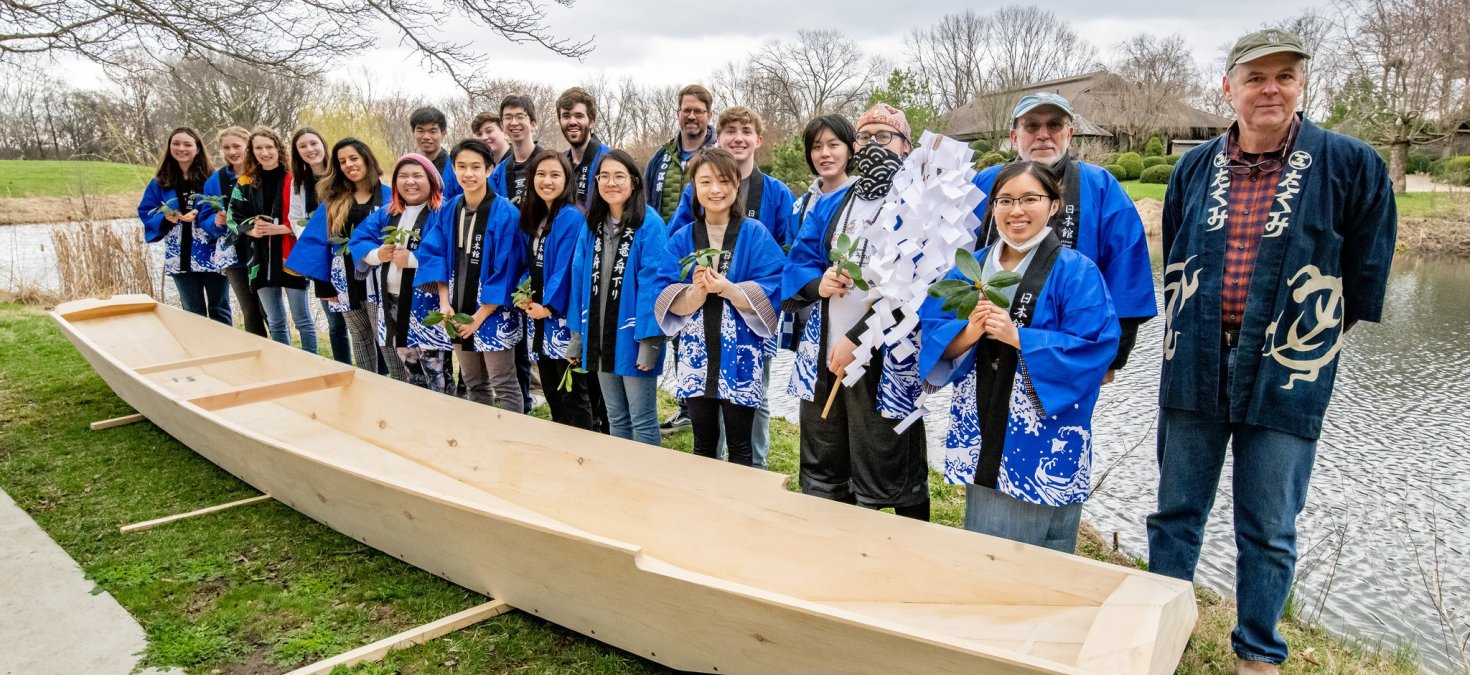
Japan House was excited to offer ARTJ 391: Independent Study in Japanese Aesthetics with a special opportunity to delve into a Japanese Traditional Boatbuilding Apprenticeship for Spring 2022 featuring artist-in-residence Douglas Brooks who specializes in Japanese traditional boatbuilding. Independent study allows for students to explore an area of interest within Japanese aesthetics under the guidance of an instructor to develop a research or creative project. This once in a lifetime opportunity focused on the direction of a creative project through a Japanese traditional boatbuilding apprenticeship. This is a hands-on, experiential course, immersed students in a traditional Japanese apprenticeship setting on the University of Illinois campus at Japan House and the Siebel Center for Design. It was developed in a hybrid manner in which students will prepare through online course materials prior to Douglas Brooks’ arrival on campus as an artist-in-residence for the hands-on woodworking component of the course. This artist residency is funded courtesy of the Arts Midwest GIG (Grow, Invest, Gather) Fund.

Douglas Brooks is a boat builder, author, and researcher who builds traditional Japanese boats for museums and private collections. Brooks is the only non-Japanese national listed in the 2003 Nippon Foundation survey of craftsman capable of building traditional Japanese boats. In 2014, Brooks received the Rare Craft Fellowship Award from the American Craft Council. In 2015, he was named an Arts in Action-Japan Fellow by the Asian Cultural Council. Brooks regularly publishes articles about his research and has published four books, including his most recent title: Japanese Wooden Boatbuilding. Brooks has been researching traditional Japanese boatbuilding since 1990, completing five different apprenticeships with various boatbuilders in Japan, focusing on the techniques and design secrets of the art and craftsmanship as well as the Japanese apprenticeship tradition of teaching boatbuilding. For more information about him, please visit his website: http://www.douglasbrooksboatbuilding.com/
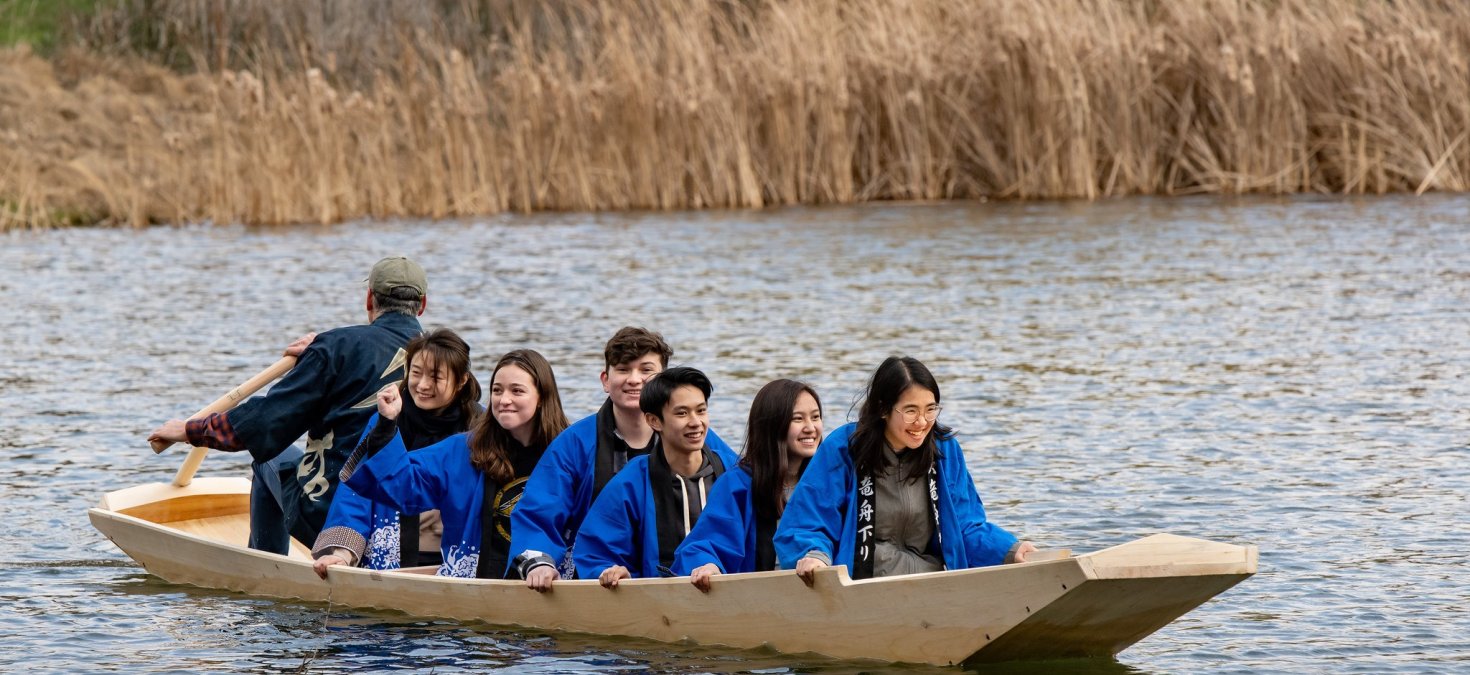
Students riding the completed boat during Spring Open House! Photo by Fred Zwicky, University of Illinois Urbana-Champaign
Students will work together under the guidance of Brooks to build one boat, based on the design of a honryousen, a traditional 21’ Japanese river boat. Japanese river boats tend to be simpler than sea boats, but they give students a chance to try all the skills of Japanese traditional boatbuilding: fitting seams with handsaws, piloting special edge-nails with unique chisels, hardwood dovetail fastenings, etc. Other skills and topics covered in-person will include design, sharpening with waterstones, and the adjustment and tuning of Japanese wooden planes.
The boat design is from the Shinano River, Niigata, and is a hard-chined, canoe-like craft used in the lagoons and estuaries of the river mouth. They are locally called itaawase ("plank built") or honryousen ("standard fishing boat"). The finished boat will be suitable for paddling by one or two people. The design can also be adapted for an outboard motor. These boats were all-purpose vessels used by farmers and fishermen in the large delta of the Shinano River.

In this image of honryousen, men are dredging sand, a seasonal job as the river channels constantly silted up. Large post-War drainage projects allowed roads to be built, which made most of these boats obsolete as farmers purchased trucks.
Note: all talks will be held at the Siebel Center for Design
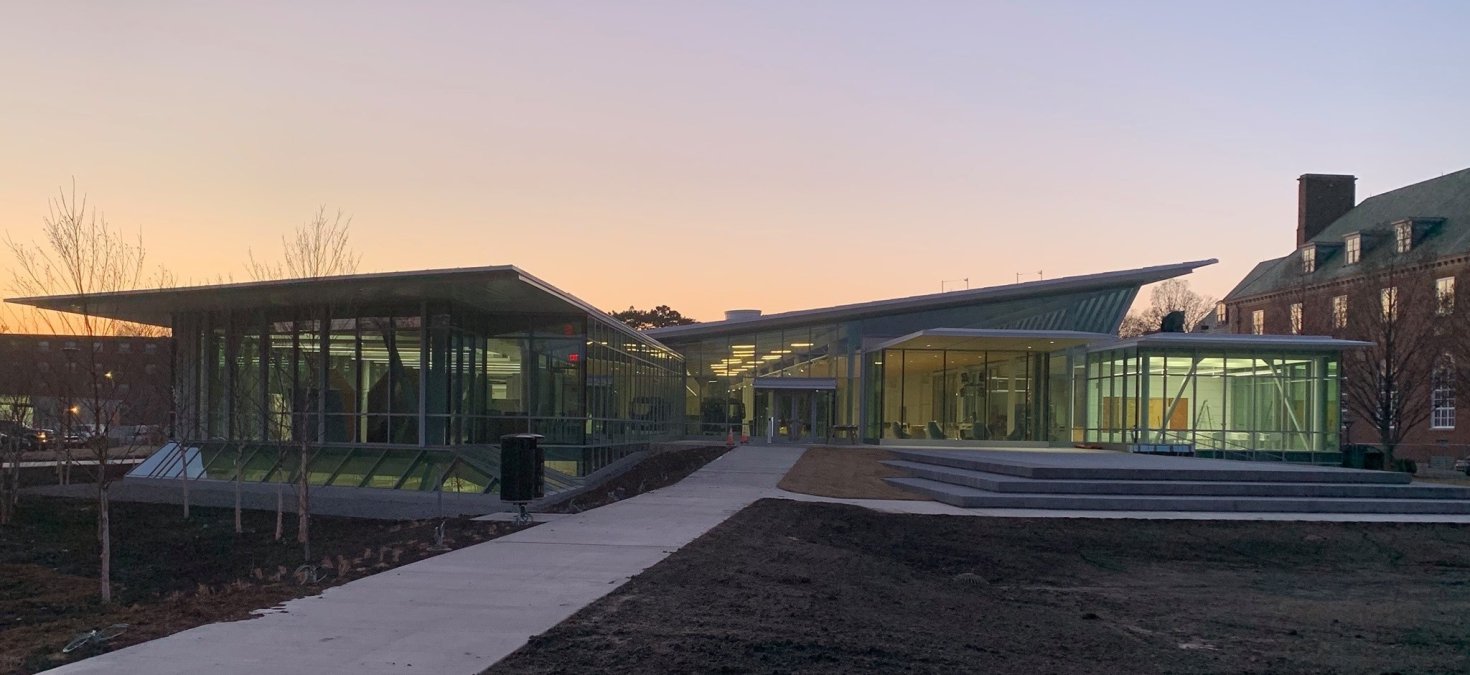
Japan House thanks the Siebel Center for Design for hosting Brooks' workspace and lectures!
The main focus of this course is the exploration of different cultural ways of learning and students are not required to have woodworking experience. Through hands-on exploration of woodworking techniques in traditional Japanese boatbuilding, students will learn about the style of teaching and learning in Japanese apprenticeships. Combined with readings and videos on apprenticeship practices in Japan, it is hoped that students will acquire a better understanding of Japanese culture, traditional arts and aesthetics, and also come to see their own culture in a new perspective.
Students will be working through seven weekly online lessons during the semester with a variety of assignments that will challenge their understanding of Japanese woodworking and apprenticeship culture and document their reflections throughout the course. The final eighth week will be in-person primarily at Siebel Center for Design where students will be working hands-on with Douglas Brooks to build a Japanese boat using traditional woodworking techniques. This in-person component will be taught in silence, with an emphasis on learning woodworking techniques through observation and practice.
Japan House Spring Open House on Saturday, April 2 will feature Douglas Brooks as the main speaker and the student apprentices will participate in a traditional boat launching ceremony in the Japan House ponds with the completed boat.
Saturday, April 2 featured a boat launching ceremony at the Japan House ponds in the afternoon. Photo by Fred Zwicky, University of Illinois Urbana-Champaign
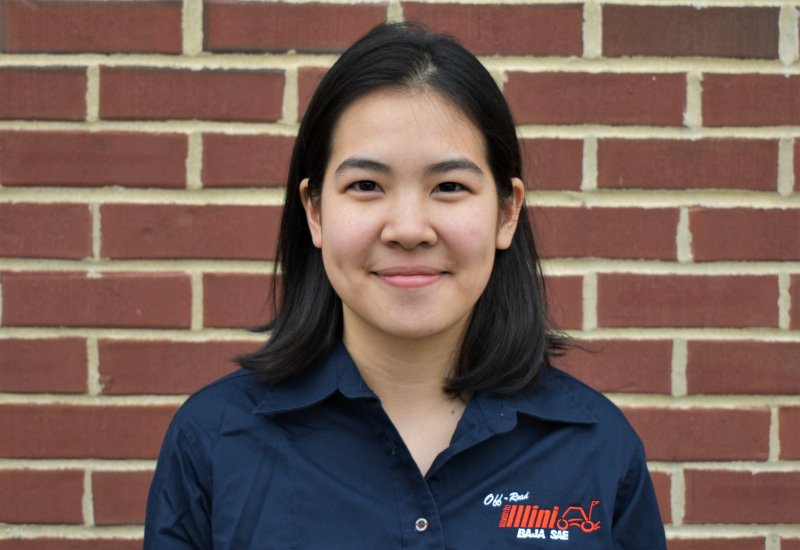
Madison Yang - Junior, Mechanical Engineering, Grainger College of Engineering
This course caught my eye for a couple of reasons. First, I like to work with my hands. It's why I chose to study mechanical engineering and has led me to participate in the Baja SAE team. Secondly, my grandfather was Japanese. He grew up in a Buddhist temple in a small town in Japan. I think this class would help me connect to that part of my own cultural heritage. I've always been fascinated with Japanese craftsmanship.
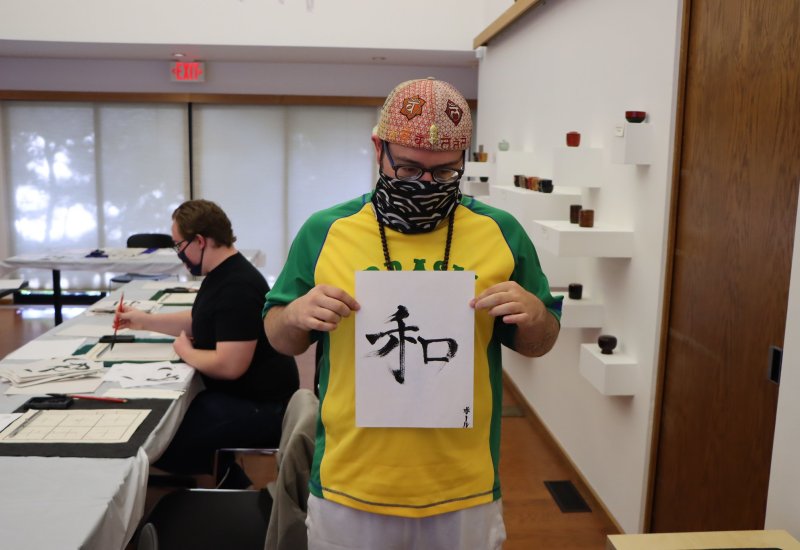
Paul Duarte-Noe - Senior, Media & Cinema Studies, College of Media
I want to take this course because a few years ago, I watched an NHK show where the host traveled around the Yaeyama islands by bike, stopping to talk to people about about local culture and crafts. She met a craftsman, Tomohiro Yoshida, who built Okinawan sabani boats using traditional methods - no metal, with bamboo pegs and wooden fasteners instead. He talked about leaving his life in Tokyo to live in Okinawa, preserving the traditional method of boatbuilding. He talked about the wisdom of the ancient boatmakers as the antidote to the hectic lifestyle he had living in Tokyo. Both his story and the craft were very interesting to me.

Kyoko Sawada - MA 1st year, Japanese Pedagogy, School of Literature, Cultures, and Linguistics
This class sounds like an amazing time. As someone who has been studying Japanese language and culture, with a focus in aesthetics, this class would be another notch in my belt for being able to teach about Japanese aesthetics specifically. My goal for the future is to be a Japanese teacher, and that includes teaching about culture alongside language.
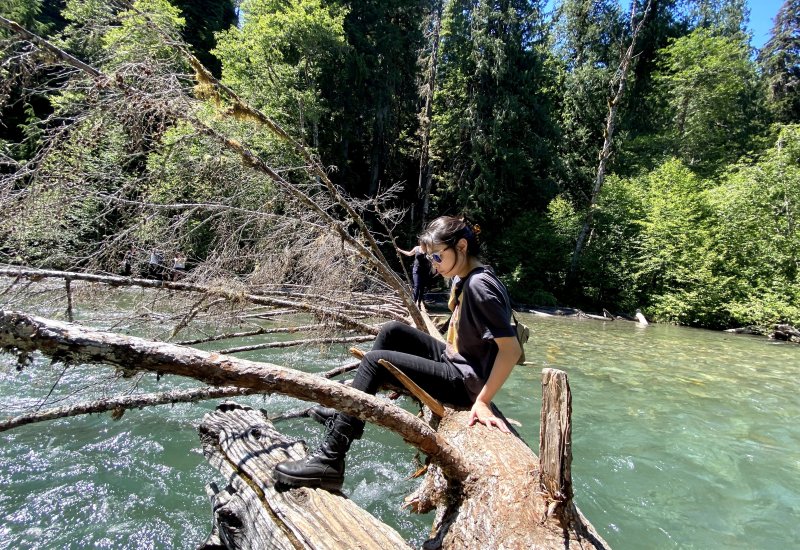
Chu Chu - 4th year PhD, I/O Psychology, College of LAS
Studying tea for the last few years has granted me numerous new perspectives for life, but one in particular, which I don't often share with the tea group, is how hands-on activities stimulates my research work. My research revolves around assessing vocational interest, in other words, people's preferences in work activities or occupations. I develop and evaluate survey instruments to more accurately assess people's vocational interests and provide fitting career recommendations. As a researcher, I have expertise in analyzing survey data, but I am a novice in most of the occupations that I have never experienced before‚ one group, in particular is hands-on, or realistic occupations.

Andrew Zoghby - Senior, Computer Engineering, Grainger College of Engineering
I would like to take this course as it is a unique opportunity to gain insight into an, arguably dying, art form. I think the chance to study experts of a field should not be passed up as they are ripe with lessons. Lessons that not only apply to the art, but help make you the best possible version of yourself. Learning styles of traditional Japanese boat building may seem very niche, but I think that hyper focusing on a subject further grows my lateral and critical thinking skills. Additionally, I think learning about the fine arts broaden my horizons very directly. Much of my life is focused around computers, and is where I am comfortable. However, it is very important that I take opportunities outside this space to prevent my self from forgetting about the arts and their importance to society. I think broad education is key to maintaining open mindedness throughout life, and this course would provide education on a topic that is not easily accessible elsewhere. Finally, while traditionally boat building is far from my professional career, and is unlikely to be applicable, I have a strong personal interest in the craft. I have taken an interest in traditional furniture building in the past and really enjoyed the craft itself. Japanese boat building uses similar tools, but is an entirely different way of utilizing them. I think intersection with western furniture will be extremely interesting, as well as how the techniques differ. This diversity will improve my skills in woodcraft across the board. I think the personal interest in fine woodcraft and boat building provides me with excitement and passion to really dive into the class. While any life lessons provide the long term motivation to dedicate time throughout the semester. I believe in "you get out what you put in" and I think I am prepared to take full advantage of the opportunity. This is not something that is easy to find upon graduation, and do not want to miss out.

Mikayla Blanke - Junior, University of Illinois Laboratory High School
I have taken Japanese at University Laboratory High School for three years. This year, I studied abroad in England for the fall semester, so I was unable to take Japanese 4, since it is a yearlong course. However, I would still like to continue building my knowledge on Japanese culture, even though I have to wait till the fall to take my next language class. I believe this would be a good opportunity to gain both knowledge and hands-on experience in an important and specific part of Japanese culture, while also helping me to retain my previous knowledge. In addition, I have participated in the Japan Bowl Competition the previous two years, and my team won the state competition both times, so we were able to also compete in the national competition. From these experiences, I have learned how interesting it can be to study and research the specific, smaller details that are so important to the Japanese community and culture. Personally, I found it a valuable and enjoyable experience, and I think it would be even better to learn in an environment where I can put what I learn into a physical format, like building a boat. I understand that this is a class that is typically offered to college upperclassmen, but I believe that I have enough experience in the Japanese language and culture to benefit from this class!

Theodore Li - Senior, Computer Science, Grainger College of Engineering
As a senior at UIUC, this will be the last semester of college for me. And when I look back on all that I've taken, what will stick with me the most isn't my technical classes, on databases and algorithms, on low end hardware to front end development. The class I look upon and will continue to use not only in my career but also in my day to day life is Chado: the Way of Tea. I initially took the class because I thought - "I'd love to have some nice tea every week and chill out!" I thought I would learn how to prepare tea and that would be about it. However, when I actually took the class, I found that making good tea was just one facet of a rich and multifaceted world that is Chado. It's all about the philosophy behind it, and pouring your mind, heart, and soul into it. How Chado is intrinsically tied with Japanese ideas of beauty and formality. I've grown to love and admire the meticulous detail placed in every small gesture, every little detail honed to perfection. I want to take Japanese Traditional Boatmaking to further my understanding of Japanese culture. I'll be honest - the closest thing I've done to boatmaking or even woodworking in general is cutting down some tree limbs in my parent's yard. But I am eager, hard working, and willing to learn. I love the feeling of becoming more and more skilled at disciplines, noticing the improvements day by day. And with each passing day, those skills shape how I see and appreciate the world. One example of this is one class where we learned about Chabana and were tasked with making our own chabana arrangement outside of class. Those days always on the lookout for flowers, blades of grass, tree branches have changed me. To this day, whenever I'm outside, part of my brain is always noticing beautiful flowers, striking tree branches, and dreary morning walks to classes have been transformed into a great time to appreciate nature! In addition, most of my current classes involve looking for hours at a computer screen and having a more physical project would be a nice change of pace. Though I may never need to build my own boat, I'm sure taking your class will teach me much about Japanese culture, philosophy, will help me to become a more well-rounded and complete person, and will be an experience I will surely never forget.

Yuting Wei - Sophomore, Art and Design + Industrial Design, College of Fine and Applied Arts
As an Industrial Designer, I am interested in hands-on activities, STEM, and cultures. As a child, I used to watch my grandfather cut bamboo into strips and weave them into baskets. Making bamboo baskets is a traditional Chinese culture. His knowledge and skills in traditional crafts astounded me. I was also curious about how my forefathers came up with this method of making baskets. I am interested in Japanese culture and believe that by taking this course, I will be able to learn more about Japan. Moreover, I've wanted to learn how to create a large-scale project since my freshman year of college. I have designed and made a motorcycle wood puzzle, and I like the process of putting wood pieces together. I'm also fascinated by mechanics, so I'd like to learn more about how the Japanese boat is built and why it functions the way it does. In addition, I'd like to gain experience working in a group. I've had some difficult cooperation encounters, but I've reflected on the situations and identified the causes of the issues. To strengthen my capacity to cooperate and communicate, I'd like to have more teamwork opportunities. Furthermore, I admire the fineness of everything in Japan Culture. Specifically, products designed by Japan are very detailed and considerate. I would like to learn their craftsman spirit. How they see things in a different way I do.
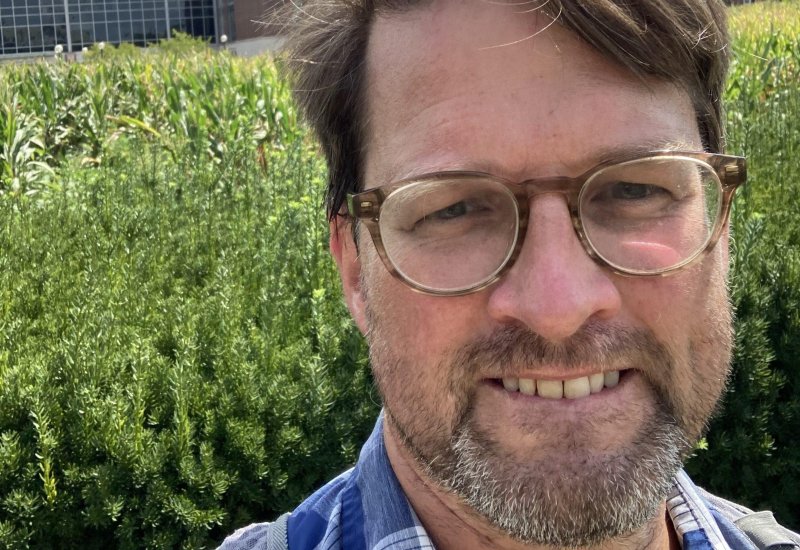
Matt Bridges - PhD graduate student doing coursework, History of Education, College of Education
Teaching is a craft, a vocation that requires a new way of seeing the world not only as it is but as it might be taught. As a teacher practices excellence in teaching the the world they see, there is a new intimacy with the world that is taught. In woodworking, in my experience, the same kind of intimacy is possible through woodcraft: the joinery practice, the fresh project that challenges skills, and the wood in grain and knot; all these bring the wood and the project's place in the world into brighter focus. I am an amateur carpenter and furniture maker, so this course would challenge me in new ways, but also be a part of a lifelong practice in woodworking.

Parima Michareune - Junior, Engineering Physics, Grainger College of Engineering
I am interested in this course because I am currently pursuing a minor in Art & Design and want to expand my portfolio and skills. This class is unique is what it teaches and the type of experience I would get. I see woodworking as a form of art and have always wanted to try it. Last year I took an art class that explored different kinds of mediums. One of the sections was focused on Japanese landscape drawings and I learned more about that style. Ever since, I have wanted to explore more Japanese art and aesthetics. I have developed a deeper interested for Japanese art, style, and culture over the past few years and am trying to seek any opportunities I can that could help me learn more. This class would help me learn more about a different kind of art style by getting hands-on experience as well as learning in a new style. This will allow me to gain new perspective in my thoughts and ideas.
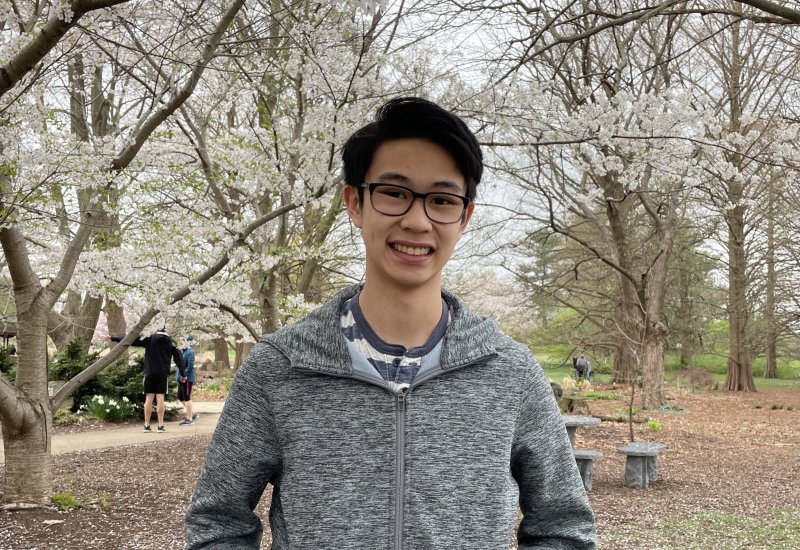
Matthew Lim - Junior, Mechanical Engineering, Grainger College of Engineering
I've always been interested in Japanese culture and art, wood working, and I love working with my hands as we do in the Off-road Illini Baja SAE club. I think being able to take part in this course will give me a unique understanding and experience in Japanese apprenticeship and allow me to explore wood working. Working in a team is one of the things I enjoy the most about Baja and I'm excited to be working with others and being able to express ourselves creatively throughout the class. I hope to gain not only skills and a passion for wood working, but more so the thought process and perspective of Japanese wood working. I hope to use the skills and knowledge from this class in my life and in other classes.

Arielle Pfeil - Senior/5th Year, Mechanical Engineering, Grainger College of Engineering
I believe this course is a great opportunity to gain cultural knowledge, hands-on skills, and get out of my comfort zone. I believe this is a very unique course being offered and is something that resonates with both my personal interests and academic/professional path. I have also wanted to take a course through the Japan House after attending a tea ceremony a few months ago and this one in particular strikes my interest. I am currently a senior/fifth-year undergraduate student studying mechanical engineering and I plan to graduate this May of 2022. Throughout my time here at UIUC, my discipline's focus has largely emphasized learning the science and theory behind designing mechanical systems and components. While engineering may focus on optimization in design, I think that science often forgets that there is an art to constructing things by hand with attention to detail and aesthetics, an art which I hope to observe and learn more about during this course. Throughout many internships and courses during my undergraduate experience, I've come to work with many people and organizations on the design of various products and devices. I think that this course will provide a new perspective for me on mentorship and an artistic point of view in the eyes of design work. After I graduate, I intend to continue on the path of engineering and more specifically in mechanical design work. Come August of this year, I have accepted a position as a product designer at Apple in the San Francisco Bay Area. Although this course in traditional Japanese boatbuilding very different from the projects I will be working on in my future job, I see this course as an opportunity to become more observant in the process of creation and patient with myself as I learn something unfamiliar to me. These are all transferable skills to my future career and even personal creations. Lastly, and most significantly, I hope to take this course because I think it will be a great opportunity for personal development, dabble in an area that I might not normally get to, and quite honestly have fun! I have always been interested in hands-on projects and the arts and enjoy activities like painting, drawing, crochet, and origami in my free time. I think this will be a very educational and fun class to take during my last semester on campus. I am very interested in learning about different cultures around the world and would enjoy both the hands-on portion of the course and the asynchronous lessons teaching me more about Japanese culture and aesthetics. I believe I would not only thoroughly enjoy the content, but truly take away something memorable and impactful after I graduate from UIUC.
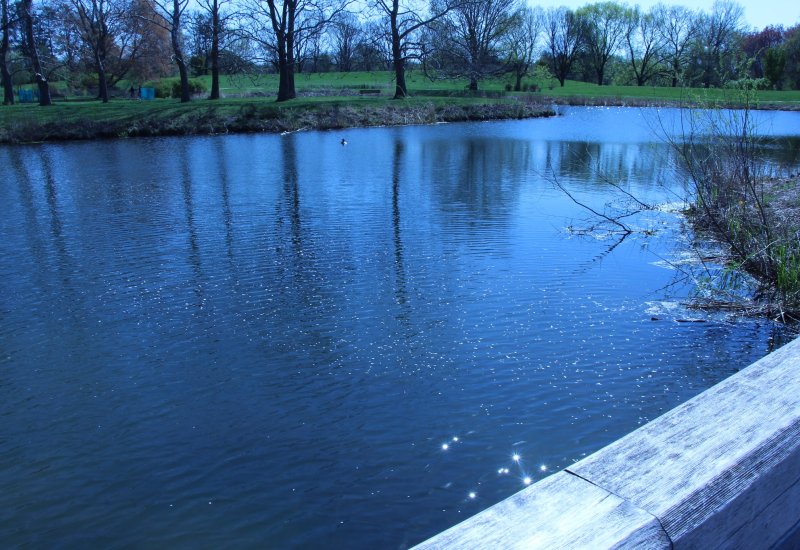
Oscar Knudson - Senior, Econometrics and Statistics, College of LAS
My desire to be a part of this unique opportunity is twofold: to aid in preserving a beautiful and historic artform, and to better myself as an individual. Art is, in my opinion, the most uniquely human form of communication that we have access to. A craftsman is able to express a wide range of emotion, history, tradition, and discipline through their work, and connect with people across space and time. Art is irreplaceable, and the act of preserving artforms is an important duty of those who are able to. By continuing traditional artforms, we can learn about those who came before us, honor them, and pass down their knowledge to future generations. In taking this course, I hope to learn from all of those who have laid the foundation and give their teachings new life in the world. In doing so, I hope that I am able to grow and overcome all personal challenges necessary to learn a craft unlike any that I have experienced. My collegiate career has yet to challenge me in such a physical, disciplined way, and I anticipate that developing this skill will help me learn in other aspects of my life. The art of traditional boat building is beautiful, and I would love an opportunity to overcome my own limitations to help preserve such an incredible craft.

Emilia Carlson - Junior, Mechanical Engineering, Grainger College of Engineering
I would like to be in this course because four of my lifelong goals are to maintain a sense of curiosity throughout life, continually improve my creativity, refine my design skills, and immerse myself in as many cultures as possible. Regarding my goals of developing curiosity and creativity, this apprenticeship stuck out to me because of the unique knowledge I would gain. Douglas Brooks has a strong knowledge of techniques of Japanese boatbuilding craftsmanship that has been passed from master to apprentice with almost no written record. Next, my desire to refine my design skills stems from my background as an engineer interested in computer aided design as well as research and development. After researching different types of traditional Japanese boats and reading about this course, I have observed an abundance of intriguing design techniques and would love to hear more about them. I am curious about how I can apply the cultural knowledge, design techniques, and life lessons from this course to my work in the future. Lastly, I am actively working towards my goal of being exposed to different cultures. I am planning on studying abroad next year and embarking on global business trips and international immersion trips through the Hoeft Technology and Management Program. This course would allow me to explore and interact with Japanese culture while understanding more about Japanese history and traditions. A specific interest of mine is improving my woodworking skills. I have started building this skill through personal projects; I have recently created customizable birdhouses, a ukulele, and I am currently working on building an electric guitar. These projects have taught me basic woodworking skills, but I believe that working with a renowned and skilled artist would significantly improve my woodworking abilities, as well as my design skills as previously mentioned. Throughout my life, one of my family traditions has been participating in an annual cardboard boat regatta. This competition is exactly what it sounds like- building a boat out of cardboard with a creative theme and racing it around a lake without the boat disintegrating or falling apart! As the years progressed, our boats improved, and we began getting first or second place consistently for design and speed. This tradition makes me look upon boatbuilding very fondly, and it would be a very full-circle experience to gain knowledge about professional, specialized, and cultural boatbuilding techniques. I have researched the artist-in-residence, Douglas Brooks, and really admire the projects he has completed and would be honored to learn from such a talented and specialized artist. Douglas Brooks has extremely valuable knowledge from his unique experiences and overwhelming amount of grants, travels (twelve visits to Japan!), and diverse projects. Reading over Brooks' biography, one experience that stood out to me was his apprenticeship to the last surviving boatbuilder of the tsunami zone in Tohoku, Japan. Being able to be a part of Douglas Brooks' dedication to reviving a rare craft technique would truly be a once in a lifetime opportunity.

Erika Jarosch - Senior, Aerospace Engineering, Grainger College of Engineering
So far in my education, I feel that the courses I have taken as an engineer are largely theoretical. We learn everything about the math and science behind construction, and rarely build anything physical in a class. For one, I would be really excited to get construction experience from this course. One of my goals is to develop a stronger 'builders' intuition, and gaining a background in woodworking seems like a fundamental place to start. Watching the Japanese artisan in the video discuss wood quality, choices, and rules which I had never considered was super interesting, and something I would like to continue studying. I would like to be in this course to learn about how those choices are made, and what differences they make to the overall construction process. One element I hope to change of my college experience before graduating is to become more involved with the campus and cultural experiences outside of just the Aerospace Engineering department. I have long wanted to specifically become involved with Japan House, as it is a beautiful and distinct part of the University of Illinois' history. Becoming a Japanese traditional boatbuilding apprentice would be a very unique opportunity to explore a culture outside of my own. I am eager to experience a new perspective, to challenge what I think I know as an engineer, and to transform my mindset in the process. Diving deeper into construction as an art form also really interests me. From what I have read and seen, the practice seems incredibly transformative, which I never expected to find in construction. Ultimately, I am extremely curious about the world surrounding Japanese boat building apprentices. I would like to explore that arena, and to see how building and creating structures can be such a personal process.

Jeffrey Tang - Junior, Computer Science, Grainger College of Engineering and College of LAS
I first heard about the boatbuilding apprenticeship towards the end of my Chado class. My teacher had told us that our days in-person would be taught in silence and that we would learn by closely observing the master. In Chado, we emphasized the importance of mindfulness. Going forward, I had vowed to pay closer attention to my five senses so that I could experience life more fully, without missing any moments. Boatbuilding seemed particularly fitting for me to hold myself to this. By being denied the ability to immediately ask questions, we are forced to glean as much as possible from our five senses alone. Every moment we miss could be a useful trick or a different perspective. Contrast this style of learning with the way in which we’ve normally been immersed: in my engineering internship right now, I am told to ask as many questions as possible. Information is relatively well-documented, and we are encouraged to write and share ideas and proposals. Thus, paying attention has lower stakes. But I believe that the method of “stealing secrets from the master” has applications to how all of us learn. At work, there are times when I have to pair with experienced engineers. Knowing which questions to ask now and which ones can be answered on our own is a delicate balance. By shifting the burden of learning further on the student, we ensure that teaching remains sustainable. In my student organization, I have seen my fellow team leads burn out so many times due to how much work it takes to complete a project while also mentoring our younger engineers. By recognizing how powerful a student’s ability to experiment on their own can be, we can help the incredible teachers of this world continue to do what they love. In addition to the in-person component, I am also looking forward to writing reflections on our weekly lessons and readings. In Chado, I discovered how effective writing was for me in organizing and preserving my thoughts. By writing reflections in this course, I hope to think more deeply about how Japanese apprenticeship culture relates to the way I personally learn. Lastly, I am just fascinated by the prospect of creating a waterproof boat whose joints are held together without any caulking. To me, this represents the peak of engineering quality: a sense of pride in the precision and elegance of the finer details of one’s work. I am also excited to help build something that will be a part of Japan House, a place that has given me so much.

Fiz Hassan - 2nd Year Masters (Track 3 Program), Architecture, College of Fine and Applied Arts
I am a female international student from Pakistan pursuing Graduate School in the United States. I was raised in a male dominated society where women are confined to the four walls of their homes and kept at bay from on ground challenging tasks. During my education, one of the main things we were taught was to pursue a field that would allow us to work from indoors. Despite learning many computer skills, I always felt the lack of practical skills such as fixing a car, putting a fuse or working shoulder to shoulder with men. I have always had interest in woodwork and that is why I took the Tier-1 training in the architecture woodshop last semester. When I came across this course, I believed I found the perfect outlet to learn and master a hands-on skill. This course would not just provide me with agility but also remove my hesitance to use tools and get the job done myself. Through this course I want to be a part of the unique experience of learning how to build a boat and in the future, advance this learning through other complementary wood courses. I hope to gain lifelong skills, improve teamwork, and make it a first practical experience I can talk about and take forward in the coming years. In 2017 I had the privilege of going to Japan and seeing their culture and wooden structures, thus it is something close to my heart. Learning the art of Japanese traditional boat building would not just be a privilege but also an honor and a big personal milestone.

Ben Macke - Senior, Music, School of Music
I was first exposed to Japanese culture through Chado, The Way of Tea, a class I took last semester at Japan House. I am looking forward to learning more about traditional Japanese art and culture through this class, and I am super excited for the hands-on experience of woodworking and boat building! A fun fact about me is I was a member of the Marching Illini all four years of my undergrad here at Illinois, and I am actively involved in a lot of music groups on campus. As a musician, it’s no surprise that all of the boat builders Brooks interviewed and learned from all share similar views about the transcription of their craft. They have all experienced the traditions and practices of this kind of woodworking, so they understand the transmission of this knowledge is from master to apprentice. It lives through each generation of boat builders through an oral tradition, much like storytelling, folk music, or the other arts.
Student apprentices carry the finished boat to the Japan House ponds for the boat launching ceremony. Photo by Fred Zwicky, University of Illinois Urbana-Champaign
“I believe exposing people to another culture’s craft offers important insights which go far beyond the craft itself. There are ways of learning we do not know and they can be important windows to the self.”
Brooks demonstrating how traditional tools and techniques are used to student apprentices. Photo by Fred Zwicky, University of Illinois Urbana-Champaign
I believe exposing people to another culture’s craft offers important insights which go far beyond the craft itself. There are ways of learning we do not know and they can be important windows to the self. The apprentice system as found in Japan is very much a values-based education system centered on the person, versus our skills-based training with its commitment to efficiency. Deeply rooted in Japanese culture, craft apprenticeship shares many elements of Zen Buddhist monastic training, such as humility, fealty to one’s teacher, repetition, and training in silence. It was not efficient; the typical boatbuilding apprenticeship was six years. In my case I worked with each of my teachers for the time it took to build one or two boats, from one to seven months. All of my teachers told me at the outset there would be no speaking in the workshop; the workday was conducted in silence.
This begs the question: how does one learn in silence? The answer lies in those long apprenticeships. While the apprentice was sweeping, sharpening or fetching tools they were constantly watching their teacher, learning by observation. It may be months or even years, but one day the master would ask the apprentice to do something, and expect them to do it perfectly. As an experienced boatbuilder, I was brought into the work fairly quickly (though my first tool was always the broom). Nevertheless, if I made a mistake, I was sent back to sweeping. I can say it made me a very highly motivated student. While one can fairly raise objections to this sort of “teaching,” it focuses all responsibility for learning on the apprentice.
I call this values-based learning - as opposed to western skills-based learning - because of the intense demands it places on the learner. It requires the humility to respect one’s teacher; powers of observation to learn every detail of the craft; and the perseverance and patience to painstakingly develop one’s skills. It requires an incredible level of focus and attention. At a glance the process can seem slavishly imitative, but in fact the crucible the apprentice finds him/herself in demands constant attention and creativity.
I often found myself working alongside my teachers, having been ordered to keep up with them while we chiseled mortises or piloted nail holes. My teachers could cut hundreds of identical mortises without laying out any lines beforehand. I could not. In desperation, so as not to fall behind (the broom was always waiting), I would quickly make little patterns out of scrap so I could trace uniform shapes consistent with their work. It may seem insignificant and hardly revelatory, but it was symptomatic of an intensity I have never found in any other educational setting. It also points to how my teachers made me responsible for every detail of the work, all without saying a word.
My association with Japan began with the straightforward goal of preserving the skills of traditional boatbuilding. Since then, I have developed a much deeper appreciation for apprenticeship, its crucial role in sustaining the craft, and what it can teach us about learning. This project hopes to do both: nurture a new generation of boatbuilders through cross-cultural exchange, exposing them to lessons both tangible and intangible.
Looking back, I am deeply indebted to my teachers for humbling me, for making me uncomfortable, forcing me to concentrate. In the end, they made me think like the apprentice they wanted me to be. They showed me how to listen for the meaning in the silence.
Student apprentices using traditional hammering and chiseling techniques as they work in silence. Photo by Fred Zwicky, University of Illinois Urbana-Champaign
Student apprentices learned about patience as they carefully saw-fitted the sides of the boat. Photo by Fred Zwicky, University of Illinois Urbana-Champaign
